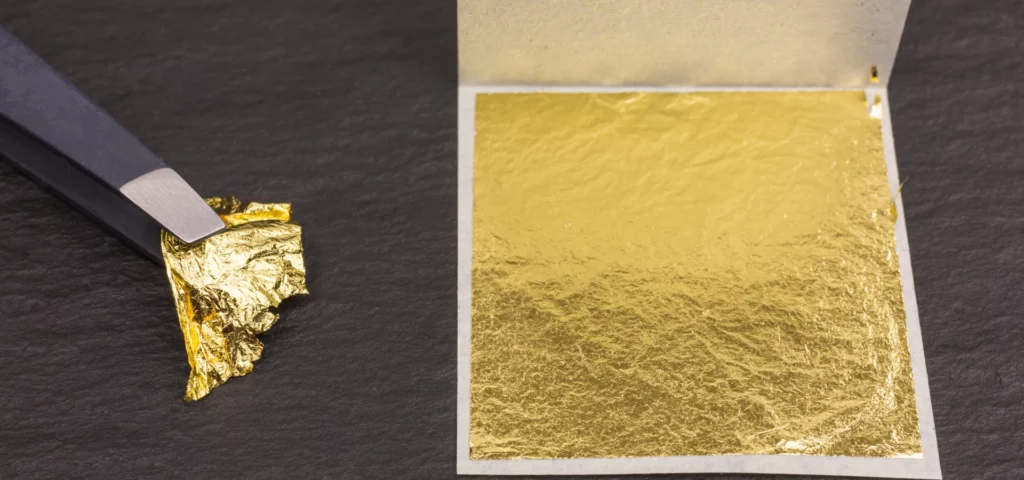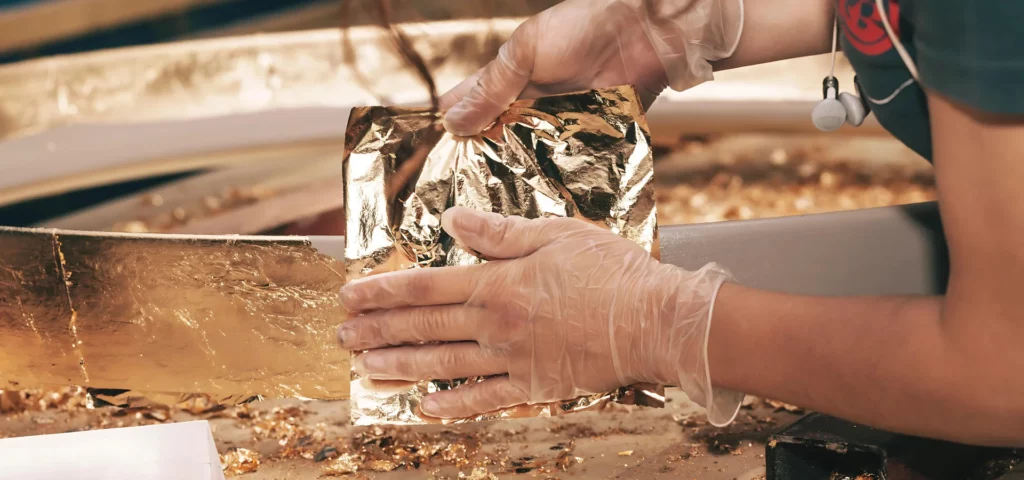Gold Leaf Adhesive Basics
Adhesive, or “size” as the pros call it, is the secret sauce that makes gold leaf stick to your artwork. Understanding the different types is key for any artist looking to gild like a pro.
Understanding Adhesive “Size”
In the world of gilding, “size” is just a fancy term for adhesive. Think of it as the peanut butter that helps your gold leaf jelly stick to the bread of your artistic creation. There are various types of adhesive sizes, each suited to different materials and conditions. The key is to choose the right kind of size for your project to ensure a smooth, long-lasting finish.
Types of Gold Leaf Adhesives
Choosing the right adhesive is like choosing the right wand in the wizarding world—it’s all about finding the perfect match. Here are the main types of gold leaf adhesives you’ll come across: (Gilded Planet)
- Oil Size: Known for its durability and extended open time, oil size is ideal for large-scale projects. It’s the go-to choice for outdoor installations and furniture where longevity is crucial. You can almost hear the gold leaf say, “Hold me tighter, for longer!”
- Water-Based Size: If oil size is the slow and steady type, water-based size is the speed demon of the adhesive world. Drying within an hour, it’s perfect for indoor use and smaller projects where you need to get the job done quickly. Cleaning up after your creative mess is a breeze with just soap and water.
- Hide Glue: Steeped in history, hide glue harks back to the days of ancient artisans. Made from animal hide, it’s a traditional choice for restorations and works that demand historical accuracy. Your gold leaf gains not just adhesion but also a connection to gilding’s illustrious past.
- Rabbit Skin Glue: Don’t let the name fool you; this adhesive is a favorite among fine artists. Known for its strong adhesive properties, it’s the ultimate choice for traditional gilding techniques. A whisper of sophistication follows every stroke with this glue.
- Gelatin Glue: The plant-based hero of the adhesive world, gelatin glue is both eco-friendly and effective. Ideal for decorating wood and stone, it offers a strong bond without sacrificing ethics. It’s like using the power of Mother Nature to make your artwork sparkle.
For artists aiming to enhance their gilding technique, exploring these adhesives can make a significant difference. Proper usage ensures the gold leaf will not flake off, maintaining the integrity of your artistic vision for years to come.
Applying Gold Leaf Adhesive
Techniques for Applying Adhesive
Getting that gold leaf to stick to your masterpiece can be a bit of a sticky situation—literally. Let’s dive into some top techniques for applying gold leaf adhesive so you can achieve a finish worthy of Midas himself.
- Brush Application: Use a soft, fine-bristled brush to apply the adhesive (also known as “size”) evenly on the surface. Make sure there are no bubbles or streaks because, trust us, your gold leaf will not appreciate it.
- Spray Application: For those who like to live on the edge, spray adhesives are your friend. Perfect for larger surfaces or uneven textures, spray adhesive can offer a smooth and even coat. Just make sure to ventilate the area unless you want an impromptu adhesive party in your lungs.
- Roller Application: Great for flat, broad areas. Rolling on the adhesive can be faster and more efficient. Just be cautious of lint from your roller unless your art is a mixed media piece including stray fibres.
- Dip and Drag: For the smaller details and edges, you can dip a precision brush into the adhesive and drag it along fine lines or intricate patterns. It’s like gold leafing with a finesse that even a catwalk model would envy.
Factors Affecting Adhesive Tackiness
So, you’ve applied your adhesive. Now let’s talk about tackiness—no, not your ex’s fashion sense. We mean how sticky your adhesive gets, which is crucial for successful gold leafing.
- Temperature: Adhesives are as fussy as aristocrats when it comes to their environment. Too hot, and your adhesive will tack up quicker than you can say “golden”. Too cold, and you’ll be waiting for it to get tacky longer than you’d like.
- Humidity: High humidity levels can delay the adhesive from reaching the perfect tackiness. A little bit of moisture is okay, but you’re not looking to recreate a rainforest climate in your workspace.
- Surface Porosity: Smooth, non-porous surfaces will let adhesive tack up quickly while rough, porous surfaces might take a bit more time. Make sure to prep your surface beforehand for consistent results.
- Type of Adhesive: Quick Dry Oil Size tacks up in about 1-1.5 hours with up to 3 hours of open time (GildedPlanet). Slow-Set Oil Size takes a more leisurely 10-12 hours to get tacky and then gives another 10-12 hours to stick that gold down before heading to the pub.
Understanding these factors will save you frustration as you apply your gold leaf adhesive.
Now that you’re armed with these techniques and factors, you’re ready to make your gold leaf stick like a pro without the sticky mess!
Working with Gold Leaf
Choosing the right gold leaf and properly sealing imitation gold leaf are crucial steps to achieving shiny, luxurious results in your art. Let’s dive into the glittering details!
Choosing the Right Gold Leaf
When it comes to gold leaf, artists have two glittering options: real gold leaf and imitation gold leaf. While one might empty your wallet faster than a week in the Bahamas, the other could be the budget-friendly buddy you need.
Real Gold Leaf: Naturally, this is made from pure gold hammered into ultra-thin sheets – think of it as the Victoria Beckham of the art world. This process, known as goldbeating, ensures a dazzling, authentic metallic finish that’s ideal for high-end art pieces. Keep in mind, real gold leaf won’t tarnish over time, making it perfect for works destined to outlive the artist.
Imitation Gold Leaf: On the flip side, imitation gold leaf is the thrifty artist’s dream. Made from a mix of copper, zinc, and brass, this faux gold leaf is designed to mimic the appearance of the real McCoy (My Art Shop). Perfect for those who want the lustre without the luxurious price tag.
| Type of Gold Leaf | Composition | Ideal For |
|---|---|---|
| Real Gold Leaf | Pure gold | High-end art, lasting projects |
| Imitation Gold Leaf | Copper, zinc, brass | Budget-friendly projects, temporary works |
Sealing Imitation Gold Leaf
To keep your imitation gold leaf looking as rich as your fantasies, sealing it properly is paramount. This step ensures that the beautiful sheen won’t fade or tarnish over time. Think of it as applying a topcoat of nail polish – you wouldn’t want that fabulous look to chip away, would you?
Surface Compatibility: Firstly, not all surfaces are besties with imitation gold leaf. The popular crew includes wood, metal, glass, ceramics, and paper (My Art Shop). Before you start gilding everything in your house, ensure your chosen surface can handle the bling.
Sealing: After laying down the golden sheets, seal the leaf with a clear, oil-based sealer or a water-based varnish. This protective layer locks in the glory and wards off the tarnishing mobs. Here’s a handy comparison:
| Sealer Type | Ideal For | Benefits |
|---|---|---|
| Oil-based Sealer | Heavy-use items | Durable, high-gloss finish |
| Water-based Varnish | Decorative pieces | Easy application, eco-friendly |
When applying the sealer, brush strokes should be light and even. If you’re feeling extra fancy, multiple thin coats can be applied, ensuring that Midas touch lasts.
Enhancing Your Artwork with Gold Leaf
Gold leaf can add a touch of drama and flair to any artistic project. Whether used to elevate a humble picture frame or to give your modern masterpiece that extra oomph, gold leaf brings a luxurious finish that catches the eye. However, achieving that perfect gilded glow requires a bit of know-how, especially when it comes to choosing the right surface and techniques.

Surface Compatibility
When it comes to applying gold leaf, not all surfaces are created equal. Thankfully, gold leaf is quite the social butterfly and plays well with a variety of materials, including wood, glass, ceramic, metal, fabric, and painted canvas (Do Dodson Designs). Knowing which surfaces are golden (pun intended) for gold leaf application can save you from unnecessary headaches.
Compatible Surfaces for Gold Leaf:
| Surface | Notes |
|---|---|
| Wood | Use a primer for best adhesion |
| Glass | Ensure the surface is clean and free of oils |
| Ceramic | Perfect for decorative items and sculptures |
| Metal | Works well with proper adhesive |
| Fabric | Requires a flexible adhesive |
| Painted Canvas | Ideal for mixed media projects |
Upgrading Your Artwork
Gold leaf isn’t just for classical art enthusiasts or those looking to recreate ancient relics—though it does a bang-up job there, too. It’s a modern marvel for upgrading your artwork, adding a metallic sheen that can transform the ordinary into the extraordinary.
- Experiment with Layers: Layering different shades of gold leaf can create unique textures and depth in your artwork. Don’t be shy—pile on the bling!
- Contrast with Matte Finishes: Pairing gold leaf’s shiny grandeur with matte backgrounds or elements can make the gold pop even more. Nothing says “Look at me!” like a bit of contrast.
- Fine Details: Use gold leaf to highlight intricate details in your work. Think along the lines of gold accents on a painted floral arrangement or gilded edges on an abstract piece.
- Full Coverage: For those who believe more is always better, go for full coverage. Just make sure the surface is appropriately prepped and the adhesive is evenly applied.
Sealing gold leaf—especially imitation gold leaf—can preserve its glowing beauty for years. Imitation gold leaf, though durable, may tarnish over time. To combat this dastardly dilemma, a leaf sealer or an oil-based varnish works a charm (My Art Shop).
So, whether you’re gilding for glory or simply adding a touch of luxury to your latest creative endeavour, knowing your surfaces and technique will ensure that your gold leaf application is nothing short of spectacular. Hold that gilding brush high, and may your artworks shine as bright as your aspirations!
Tips for Successful Gold Leafing
Ensuring your gold leaf project sparkles with brilliance requires mastering a few key techniques. From brushing on adhesive to sealing your gilded glory, here’s how to laugh your way to adhesive success.
Proper Adhesive Application
When it comes to applying gold leaf adhesive (commonly known as “size”), precision and patience are your best friends. Think of it as the foundation to your golden masterpiece. Here’s how to do it right:
1. Choose the Right Brush: For applying adhesive, an artist’s brush works wonders. Make sure the bristles are soft and fine to avoid leaving brush strokes.
2. Wait for Tacky Glory: After applying the adhesive with your trusty brush, the waiting game begins. The key is to wait until the size is tacky enough before you lay down the gold leaf. The ideal tack time depends on the type of size you’re using and environmental factors like temperature and humidity.
3. Test for Tackiness: The most critical step in obtaining a properly gilt surface is testing the adhesive sizing’s tack time, ensuring professional results. The adhesive should feel sticky but not wet to the touch.
Sealing Techniques and Recommendations
Once your gold leaf is applied and you’re basking in its glow, sealing it properly will keep it shining brightly and protect it from tarnishing or damage.
1. Pre-Paint Sealing: If you’re planning to paint over your gold leaf, a pre-paint seal is crucial. This step involves sealing the leaf before any paint touches it. This prevents the paint from seeping into the delicate gold layers (Nancy Reyner).
2. Post-Paint Sealing: Once your artwork is complete, it’s time for a final protective coat. Opt for an archival varnish with UV protection to keep your piece safe from the ravages of sunlight and time.
These steps for proper adhesive application and sealing techniques will ensure your gold leaf projects glimmer and last.
Advancements in Gold Leafing
Gold Thinning Technology
Gold leaf has always added a touch of opulence, but achieving that thin, delicate sheet requires some serious tech wizardry. The process starts with hammering gold into thin sheets, and modern advancements have taken this to the next level. Ancient techniques used thick gold foils that were applied mechanically. However, modern methods have perfected the art of creating ultra-thin gold leaf, often just microns thick (ScienceDirect).
Recent innovations in this delicate hammering process have introduced precision machinery, ensuring that the sheets are uniformly thin and even. With these high-tech tools, manufacturers can produce gold leaf that is not only thinner but also more durable, enhancing its application in artwork. A table to demonstrate the evolution of gold leaf thickness over time:
These advancements in gold leaf thinning technology not only preserve the luxurious appearance but also improve the longevity and durability of the application.
Evolution of Gilding Techniques
If you think applying gold leaf is as simple as ‘stick it and flick it,’ think again! Gilding techniques have evolved significantly over the centuries. Initially, gold was applied mechanically without any adhesive. However, as artists realised that their prized works were flaking away, they turned to animal and vegetable-based adhesives to keep the gold firmly in place (ScienceDirect).
Today, modern adhesives make gold leafing a cinch, even for the novices. Contemporary gilding techniques involve sophisticated adhesive “sizes” that ensure better adhesion, resulting in fewer touch-ups and repairs. The evolution of these adhesives has seen the shift from simple glues to more advanced formulas designed for long-term preservation. This is particularly important for sealing imitation gold leaf, which prevents tarnishing and maintains that golden glow over time.
Moreover, today’s artists have a plethora of gilding techniques at their disposal. Traditional water gilding involves using a clay and rabbit skin glue base, then applying gold leaf and burnishing to a high shine. Oil gilding, on the other hand, is more suitable for exterior works as it adheres better to surfaces that encounter the elements.
As a result of these advancements, modern gilders can produce artwork that not only looks stunning but also stands the test of time. Better adhesives, improved application techniques, and the amazing transformation of gold leaf itself have all contributed to this artistic evolution.
In short, the evolution of gilding techniques and gold thinning technology has transformed how artists apply gold leaf, ensuring that each piece remains a gleaming masterpiece for years to come.


